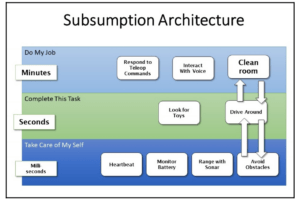Govers explains in detail what the OODA Loop stands for in the design of robotics by using a metaphor. “The lower, inner loop takes priority over the slower, outer loop, just as the autonomic parts of your body (heartbeat, breathing, eating) take precedence over your task functions (going to work, paying bills, mowing the lawn)”. This mechanism is essentially true for both humans and robotics. We first need to meet our requirements of ourselves, according to Maslow’s pyramid of needs, the very basic survival needs. And then we have the energy to accomplish other “higher” tasks. This is exactly how robotics differs from us. There is always a motivation behind us to do something. If our survival needs are threatened, we will seek a plan for our initiative. However, this is not the case for a robot. To some extent, it is not able to “take care of” itself. Even if the buttery is about to run out, it will still carry out the tasks programmed by the OODA Loop and if not previously programmed, it will never try to find a way to recharge.

The subsumption architecture is a framework identifying the importance of the different levels of the work. Though they are all called work, there is a sequence of being completed. For instance, lifting the object without damaging itself. In this case, keeping itself is that task with the priority, and then it’s followed by lifting the object.

As for the definition of AI, the author says“In general, it means a machine that exhibits some characteristics of intelligence—thinking, reasoning, planning, learning, and adapting. It can also mean a software program that can simulate thinking or reasoning”. I find it interesting because when designing a robot, in some cases, appearance comes first. While the most important part is its brain, the AI making decisions. There are some misunderstandings about how AI will affect our life. “One common myth is that robots are taking jobs away from people. In truth, robots and automation free up workers to do more productive tasks”. I believe, eventually, those labor-heavy jobs replaced by robots will push people to other positions, for instance, maintaining the robots, and other more complicated intellectual-heavy jobs. This will be another spark pushing society to develop the technology. And he also points out that “the source of this fear can be found in any bathroom, hanging on the wall – we are reflecting our own motivations and desires onto our creations”. We, human beings have the ability to create something that we are afraid of. This is the nature of every species to be exclusive to something that might threaten their survival. But if this is the only path to evolve, we shouldn’t reject it, instead, as transhumanists argue, embrace this result.



